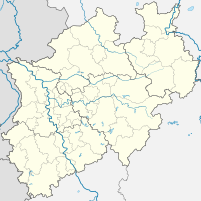Walsum south harbor
| Walsum south harbor | |||
|---|---|---|---|
| Data | |||
| owner | ThyssenKrupp | ||
| operator | Railroad and ports | ||
| start of building | 1903 | ||
| opening | 1905 | ||
| Port type | Inland port | ||
| Throughput | approx. 2,000,000 t | ||
| Geographic information | |||
| place | Walsum | ||
| country | North Rhine-Westphalia | ||
| Country | Germany | ||
| In the foreground the southern harbor of Walsum with the Walsum power station at the northern harbor , in the background the Voerde power station | |||
| Coordinates | 51 ° 31 '5 " N , 6 ° 43' 15" E | ||
|
|||
The southern port of Walsum , along with the northern port of Walsum and the factory port of Schwelgern, is one of the three large private Duisburg coal and smelter ports north of the Ruhr and is located in Walsum on the Lower Rhine on the right bank of the Rhine . It is one of the northernmost ports in the area of the city of Duisburg and today belongs to ThyssenKrupp as part of the railway and ports .
history
1903–1905 the Rhine port of the Gute-Hoffnungs-Hütte Oberhausen was built as a factory port and in 1922 a second port basin was added.
A works railway connected the port with the chemical works in Sterkrade and the mines until 1994 and the Lohberg (until 2005) , Wehofen (until 1933) and Friedrich Thyssen (until 1976) mines with the Gutehoffnungshütte in Oberhausen and the mine connection until 2005 .
In 1901 Gutehoffnungshütte Oberhausen applied for the construction of the port, which was expanded in two stages. In 1904/05 the loading bank on the Rhine and the harbor basin behind it were built. In the years 1912 to 1920 the quay was extended by 120 m and a second harbor basin was added to the east of the existing harbor basin. The plan, which shows the situation after the Second World War , shows the eastern open space as ore , the area between the 1st and 2nd port basins as a coal storage area .
Electric crane bridges each spanned an open area from one loading bank to the other. The port with a rail connection and electrically operated handling facilities served both the ore supply for the blast furnace operation and the dispatch of iron and steel products to the Gutehoffnungshütte, which also owned the neighboring shipyard . The walls of the flood-proof Rhine quay were built using massive construction . The quays of the harbor basins consisted of square sink wells with intermediate vaults.
The Rheinwerft Walsum der Gutehoffnungs-Hütte, which was the most efficient shipyard in Europe for building inland waterways, was also located in the immediate vicinity of the port. In 1982 the shipyard was closed.
In 1962, a new factory for coated printing papers was built by Haindl Papier in Duisburg-Walsum near the port . It then later came from Haindl to the Norwegian paper company Norske Skog and produced LWC papers .
On June 5, 2015, the group announced that it would close the plant. The management filed for bankruptcy on the same day .
At the end of 2016, the settlement business was stopped and the premises were sold to the Duisburger Hafengesellschaft Duisport .
For a long time imports of bulk goods outweighed exports. Today , the port, which is called by Rhine-Sea ships as well as small French and Belgian ocean-going motor ships, is mainly used for exports. The port now has a hall in Basin I for handling sensitive steel products in any weather.
Around two million tonnes of goods are handled every year, mainly finished products from the steel industry that are sensitive to moisture .
The old quay is currently being renovated in the southern Walsum harbor in Duisburg in order to make it fit for the future. In the near future, ThyssenKrupp Stahl AG plans to use a new slab store to handle and temporarily store more than 250,000 tons of steel slabs from the new plant in Brazil . The steel slabs are delivered by ship, forwarded with transport machines and then stacked with forklifts in the storage area up to a height of 2.60 m before they are distributed to the plants.
Web links
Individual evidence
- ^ Gregor Herberhold: Ships made in Duisburg-Walsum , WAZ, March 13, 2013.
- ↑ Rp Online: Duisburg: Almost 300 jobs in Walsum paper mill will be lost. In: rp-online.de. June 5, 2015, accessed July 24, 2015 .
- ↑ Oliver Schmeer: Off for paper mill in Walsum - 300 jobs affected. In: derwesten.de. June 5, 2015, accessed July 24, 2015 .
- ^ Hope at the Walsum paper mill Norske Skog. In: radioduisburg.de. July 10, 2015, accessed July 24, 2015 .
- ↑ EUWID paper and pulp: Insolvent paper mill Walsum sold to Duisport | EUWID paper and pulp. Retrieved July 10, 2017 .
- ^ Hafen Walsum-Süd ( Memento from June 21, 2006 in the Internet Archive )
- ↑ Custom-made product for extreme loads - slab storage facility, Duisburg , InformationsZentrum Beton GmbH.

